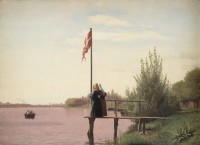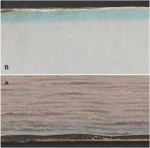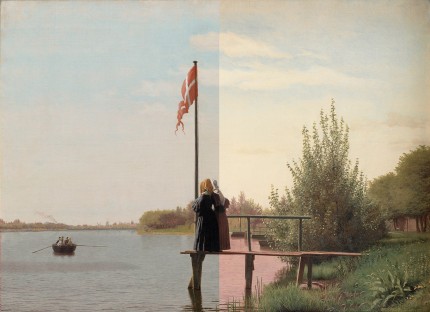 Conservators at the National Gallery of Denmark (SMK) have discovered that View of Lake Sortedam, an 1838 landscape by Christen Købke that was thought for decades to depict a romantic sunset reflected in the russet lake waters, is in fact a bright sunny day over blue lake waters. Two women standing on a jetty seeing off a party in the rowboat on a summer evening at sundown is a wistful, melancholic scene. Make it high noon and the romantic theme of separation is distinctly less emphatic.
Conservators at the National Gallery of Denmark (SMK) have discovered that View of Lake Sortedam, an 1838 landscape by Christen Købke that was thought for decades to depict a romantic sunset reflected in the russet lake waters, is in fact a bright sunny day over blue lake waters. Two women standing on a jetty seeing off a party in the rowboat on a summer evening at sundown is a wistful, melancholic scene. Make it high noon and the romantic theme of separation is distinctly less emphatic.
The artist painted the lake, which was then outside the old city of Copenhagen in a liminal suburb between the city and the rural country, with the express goal of getting it into the yearly exhibit of the Royal Academy of Fine Arts in Copenhagen. Rumor had it the Danish King was interested in acquiring the painting for the Royal Picture Gallery (now absorbed into the National Gallery of Denmark), and indeed, after the landscape was exhibited at the Royal Academy show in 1839, it was purchased by the monarch. View of Lake Sortedam was the first painting by Christen Købke in the Royal Picture Gallery.
That proved to be the pinnacle of his career during his lifetime. At the end of 1838, flush with a travel stipend from the Royal Academy, he traveled to Italy. Upon his return in 1840, he abandoned the romantic nationalism of his earlier work in favor of scenes based on sketches from his travels. These were not well received. He submitted one of those Italian landscapes in his application to become of a member of the Academy in 1846 and was rejected. Two years later he died of pneumonia at the age of just 37.
The importance of View of Lake Sortedam, in terms of subject matter, execution and period, was not recognized for more than a century after his death. In 1841 the King had the painting moved to his private apartment in Christiansborg Castle where it remained for 25 years. It only went on public view in 1864 when it was returned to the Royal Picture Gallery. When the National Gallery was established in 1896, Lake Sortedam moved there with the rest of the Royal Collection of Paintings, but as recently as the 1970s it was hanging above a door, not a location commensurate with its significance.
In the 1980s, art historians began to recognize the piece was one of Christen Købke’s most important paintings and it took a prominent place in exhibition of the artist’s work at home and abroad. It is now considered one of the signature Danish Golden Age paintings in the collection.
 With little attention paid to it for a century and a half after it was painted, View of Lake Sortedam changed without people noticing it. The contrast between the pale blue of the sky and the red of the lake had caused some art historians to wonder if it was a natural phenomenon — the sun setting out of frame to the right could make the lake red while the sky was still light — or if perhaps the color had shifted over time.
With little attention paid to it for a century and a half after it was painted, View of Lake Sortedam changed without people noticing it. The contrast between the pale blue of the sky and the red of the lake had caused some art historians to wonder if it was a natural phenomenon — the sun setting out of frame to the right could make the lake red while the sky was still light — or if perhaps the color had shifted over time.
Conservators at the SMK took small samples of paint from the lake and sky both in areas where they had been protected from the sun and exposed to it. The samples were analyzed using X-ray fluorescence and Raman spectroscopy to identify the chemical components of the paints Købke used.
The colours have changed due to a chemical reaction in the blue pigment, which is known as Prussian blue. The colour changes have been exacerbated by 176 years of exposure to light.
The sky has become paler and lighter. And the lake, which was painted using a mixture of red, blue, and white pigments, was originally a bluish grey. Now, however, it has taken on a reddish, purplish hue. The frame in which the work is set has protected the original colours out at the very edge – and this difference in colour piqued the conservator’s curiosity.
Kasper Monrad, senior researcher at the SMK, states that this new discovery completely changes how we should look at this painting. Up until this point the work was believed to be a romantic sunset scene. In the mid-1830s Købke painted many romantic artworks – and this work has been regarded as part of that group. In light of the new knowledge – that the scene actually shows a bright summer’s day – the work must be regarded as far less romantic in scope.

Looking st the shadows should have told them the sunset deal was not right.
As a painter, I can tell you that isn’t necessarily the case. Late in the day when the sun is low and obscured (as it often is in Copenhagen), the sky is still quite bright. Skylight can create shadows very like those seen, so it is not surprising that the painting was taken to be late in the day. I often see this in my own backyard. I did think the painting looked a bit off, and the color shift accounts for that. As soon as I read “Prussian blue”, I knew what had happened!
I stand corrected, but how would that occur?